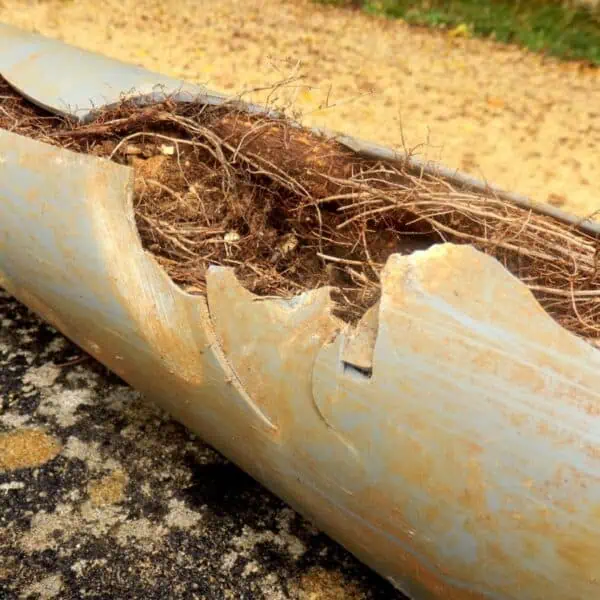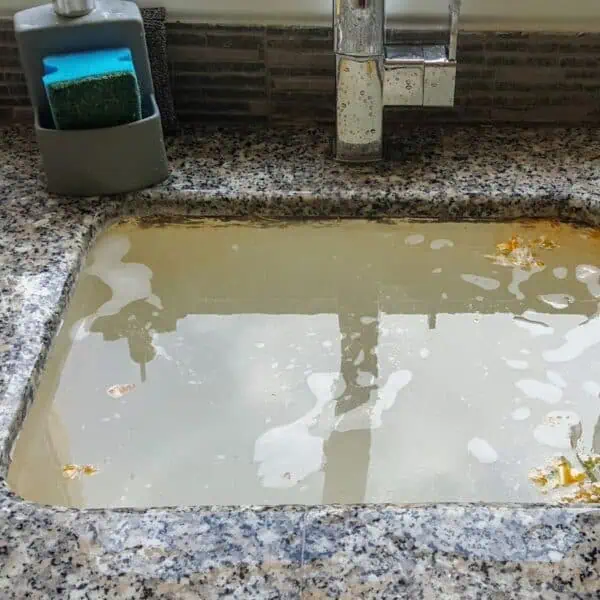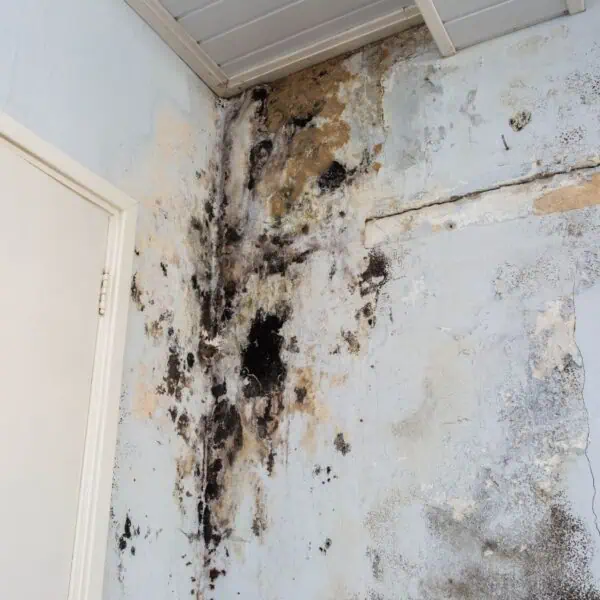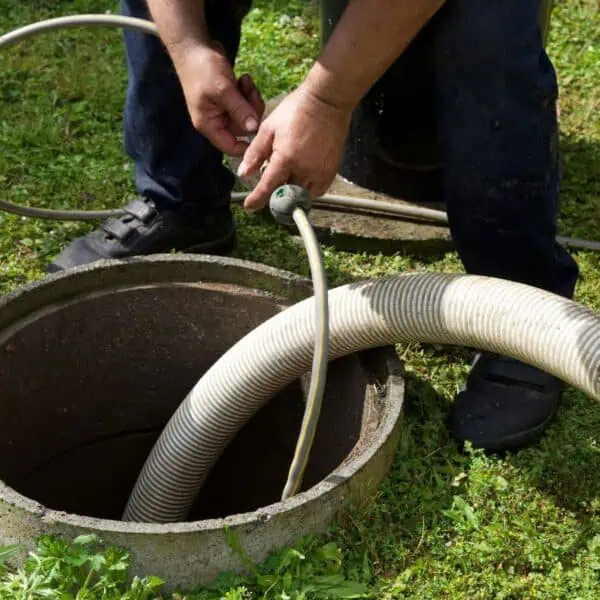Spotting the early warning signs of a sewer backup is not just about preventing a costly repair, which may be beneficial, but more about protecting your home and family from the bacteria and viruses found in sewage. No one wants sewage problems! They stink, they are a struggle, and they are bad in every way! If you see the warning signs early on, you can handle small situations before they become disasters, flooding your basement with … sewage, you get it. When sewage backs up in your home, the cost of proper remediation alone can run $3,000.00 or, in some cases, much more.
Causes of Sewer Backups
Understanding what may have caused your sewage to be clogged is useful in determining if your sewage is leaking. Let’s take a look at the usual suspects.

Tree Roots
That beautiful tree in your yard? It could be telling a completely different story underground. To trees, everything is looking for water, and your sewage pipes are going to be their all-you-can-eat buffet! When a tiny root finds even a tiny crack in your pipe, it will make its way inside, and it will grow.
Eventually, these will become large clogs. It will hold onto the toilet paper and waste and everything else that is trying to pass through, and can even collapse your pipe completely.
If you have large trees within 30 feet of your sewer line, be careful! The growing season is worse in the spring and summer, which is when roots are expanding quickly.
Clogged or Broken Pipes
On a daily basis, you may be clogging your pipes without knowing it. Here are some of the biggest offenders of condensing clogs:
- Grease from cooking that hardens in pipes
- “Flushable” wipes (which never really break down)
- Hair and soap scum
- Tampons and cotton swabs
- Food waste, especially potato skins and coffee grounds
Pipes simply just get older! Many older homes have clay or cast iron pipes that will succumb to aging, where the materials break down over a long period of time. Clay pipes crack easily, and cast iron pipes rust from the inside out, creating rough edges that catch on anything passing through them.
Different pipes have different life spans:
- Clay pipes- 50-60 years (due to tree root intrusion)
- Cast iron- 75-100 years
- By the way, PVC pipe- 100+ years
If your home is on the older end, your pipes very well could simply be reaching the end of their life.
Pipe Misalignments and Sagging
Offset Pipes: Misaligned pipe sections, known as offset pipes, can occur due to shifting soil, improper installation, or heavy traffic. These misalignments impede the smooth flow of water and waste, potentially causing recurring clogs and eventual pipe damage.
Pipe Belly: A pipe belly refers to a sag in the sewer line where waste and water can accumulate. This dip, often caused by soil settling or poor installation, leads to stagnant buildup and frequent blockages. Addressing pipe bellies promptly is crucial to prevent long-term damage.
Both offset pipes and pipe bellies disrupt proper drainage and may necessitate professional intervention to restore optimal sewer line function.
Weather Issues
Weather can be tough on sewers. Heavy rain can overload city systems and back up water into your home. If this happens to you, you should consider installing a sewer valve or a sewer alarm. During floods, groundwater seeps into sewer lines through tiny cracks. While in cold areas, freezing and thawing put serious stress on pipes as water expands and contracts if your sewer line is above the frost level. With changing climates bringing more extreme weather, sewer backups from storms have jumped about 30% in the last ten years—something worth considering when the next big storm rolls through your neighborhood.
City Sewer Issues
Sometimes it may not be your fault at all – collapsed, clogged, or overwhelmed city sewer mains can back up wastewater into your home. Many sewer systems in the U.S. are extremely old (engineers give them a D+), with some of their pipes being anywhere from 50-100 years old since their last replacement. New housing developments often connect to these old systems without upgrades or proper attention, putting more strain on already burdened pipes. The most frustrating part is that when the city is at fault, your home is the one that suffers the damage – so either way, you need to be on the lookout for backup signs regardless of fault.
Indications of a Sewer Backup
How do you know if it’s a sewer problem? Here are some signs to look for:
Water Issues
A slow drain is usually the first sign of sewer problems. One slow sink might be just a local clog. If all the drains in your house are slow, on the other hand, your main line is trying to tell you something. Pay attention to how drains interact with each other; if running the washing machine makes the toilet bubble or backs up the shower, you know you have a problem.
Water takes the path of least resistance, so when your main is blocked, it will come up the lowest points of your home. Look for standing water in basement drains, showers, or tubs (the water level should never be above the bottom of the drain), and keep an eye out for suspicious wet areas in your yard between the street and your house. This is especially pressing during a dry spell when it would be odd to see wet spots, which often indicate where your sewage is leaking into the ground, where it shouldn’t.

Strange Sounds
Your plumbing is supposed to be quiet, so if there are any weird noises, they are definitely a sign that something is wrong. Gurgling noises are an indication that you have an air gap in the house plumbing system because water isn’t moving past your clog after you flush or run the water. Pay attention if your washing machine or dishwasher is making weird noises when draining water out from the washing cycle or washing dishes. This could mean that the water cannot properly exit through the main line that the appliance is trying to drain to. If you hear the “glug-glug-glug” sound after flushing the toilet, then you are getting plumbing help signals from your pipes. This is a signal that can and will lead to more complex plumbing problems.
Awful Odors
There’s no way around it—sewage smells terrible, and when horrible odors are coming out of your drains, your nose is telling you that there are sewage gases trapped in your pipes. The odor can smell anything from slightly musty to basically raw sewage, and that is not just gross, it’s dangerous. Sewer gas can irritate your health, and in high concentrations, sewer methane gas can explode. When the rotten egg smell is going throughout your entire house, even though you’ve cleaned the drains individually, you’re usually dealing with a mainline drainage problem as opposed to localized clogging of individual drains. The odor is typically strongest in bathrooms, but can be throughout your home, and it indicates that you have big problems that need to be investigated quickly.
Other Warning Signs You Might Miss
Sometimes sewer problems aren’t obvious right away. How do you know if your sewer is backed up when there’s no water backing up yet? Look for these sneaky warning signs.
Signs in Your Yard
Your lawn can tell you what is going on underneath; an unusually rich green patch in line with your sewer line probably indicates that leaking sewage is fertilizing this seeping soil. That can look really nice, but the source is a concern. More concerning would be subtle dips or sinkholes being made as the leaked sewage is washing away the underground soil. Which new dipping areas you may want to put a little attention to, are the areas that are appearing in line with your sewer pipe as you head to the street. The pinpoint new dips may start small and may first just be an area where rain collects, but they can quickly get worse–serving as critical clues to underground sewer problems that require attention if they persist. Easy-to-defect warning signs are pools of standing water in your yard when it hasn’t rained in a while. Especially if that water is discolored or odorous.

House Damage
Sewer problems can eventually damage your house itself. You might see cracks in your foundation as sewage erodes the soil supporting your home. These often start tiny but get bigger over time, leading to big structural issues.
Check for water damage on walls, especially in basements—bubbling paint, peeling wallpaper, mold, mildew, or water stains. People often think these are just from general dampness, but they could be signs that sewage is seeping through your foundation.
If your basement gets damp when it’s not raining, that’s not normal. Most basements get wet during rainy times, but moisture during dry weather often points to plumbing problems, not groundwater.
Health Risks
The presence of persistent mold and mildew in the basement, or around drains, usually is an indicator of constant moisture from sewer problems—sewage moisture provides the ideal environment for mold growth, which can result in respiratory issues and further health and breathing problems in the future.
If you’re seeing abnormal bug activity, especially drain flies and roaches or water bugs, you probably have a drain, sewage, or standing water issue. Pests are attracted to standing water or sewage leaks because bugs and pests like roaches consume and thrive on damp, organic materials. Backed-up sewage creates major health safety concerns because sewage contains bacteria, viruses, fungi, and parasites that can create stomach issues as well as serious infections in humans.
The EPA has identified over 100 types of viruses that can live in sewage for weeks, making it especially dangerous for children, older adults, and those who are immunosuppressed.
How to Be Sure You Have a Sewer Line Clog
Unsure if you have a sewer backup? Before you contact a plumber, there are some tests you can perform.
First, flush a toilet on your bottom floor and look at your shower and tub drains nearby. If you see water come up through either of these drains, you do not simply have a blocked toilet. You have a change in your plumbing system because of a blockage somewhere in the main line.
If you can find a sewer clean out in your house (which looks like a capped pipe protruding from your foundation or between your house and the street) remove it (slowly, standing back). If sewage pops off and sprays everywhere, or sewage pools just below the opening, you definitely have a backup.
Another easier way to check for a blockage somewhere in your plumbing system is to just run water in one place, then observe what happens elsewhere. You could run your washing machine while looking at your shower drain, or turn on your bathroom sink while looking at your toilet. If they are affecting each other, something is not working correctly with your plumbing.
Don’t pour drain cleaners down your drains while trying to solve the problem yourself. You could do worse harm to pipe work (very bad!), plumbing systems, or put the lives of plumbers in jeopardy!
What to Do If You Think You Have a Backup
If you think you have a sewer backup, you need to move quickly to limit damage. How serious is it? If you see raw sewage entering your home or multiple drains acting up together, here are some steps to take:
Turn off your home’s main water supply to prevent more water from entering your plumbing system. Look for the shutoff valve where water enters your home—usually in the basement, crawlspace, or utility room.
Be aware of electrical dangers. Turn off the power to areas with water, especially near outlets or appliances. If your circuit breaker panel is in a flooded area, stay away and call an electrician.
Avoid contact with sewage—it contains harmful bacteria and germs. If you must go near it, protect yourself with rubber boots, gloves, eye protection, and a face mask to avoid breathing in sewage particles.
While waiting for a plumber, stop using all the water in your home. Don’t flush toilets, run appliances, or use sinks. Any water you send down will likely come back up somewhere else.
For minor backups, you might try a plunger, but stop if you feel resistance or the problem worsens. Remember that plunging one drain might force sewage up through another.
Call a professional if you notice:
- Multiple drains are backing up at once
- Sewage rising through drains
- Backups that keep returning after clearing
- Water appears in unexpected places when using other fixtures
Make sure you are as specific as you can when you call a plumber. Help them understand what has happened for you by telling them which drains have been problematic, when you first started noticing an issue, any unusual noises or smells, and what you have done up to that point to try to fix it yourself. In many cases, an HD sewer camera inspection will pinpoint the issue before extensive cleaning or excavation is done, and sometimes needlessly.
Preventing Sewer Problems Before They Start
The best way to handle sewer issues is to prevent them entirely. But how do you check for potential backups before disaster strikes? Regular maintenance is key.
Have a professional inspect your sewer line periodically—yearly camera inspections for homes over 40 years old, every 3-5 years for newer homes. Clean your drains regularly with enzyme-based cleaners that use helpful bacteria to break down organic buildup without harming pipes. Many plumbers recommend using these every few months.
If you have a septic tank, stick to a regular pumping schedule—typically every 3-5 years, depending on household size. Skipping this maintenance is a leading cause of septic failures, which cost far more to repair than to maintain.

Be careful of what goes down your drains. Despite their name, “flushable” wipes don’t break down like toilet paper. Never flush tampons, cotton swabs, or dental floss—these cause countless clogs. In the kitchen, never pour grease or oil down drains; let it cool and throw it in the trash instead. Use drain screens in showers and sinks to catch hair and debris before they enter your pipes.
Consider installing protective devices like backwater valves, which prevent sewage from flowing back into your house during city sewer backups. Keep your sump pump and drainage systems working properly, testing them regularly. If you have large trees near your sewer line, install root barriers to direct roots away from pipes.
Keep Your Home Safe and Dry
Now you know the signs of a sewer backup—slow drains everywhere, gurgling toilets, foul smells, weirdly lush lawn, water damage, and basement puddles. Remember, sewer problems do not get better—only worse.
Routine inspections, being aware of what goes down your drains, and having protective devices installed can save thousands in repairs and protect your family’s health. Your sewer system may be out of sight, but remember to consider it is one of the smartest things you can do to be a responsible homeowner.






